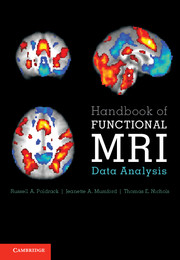Book contents
- Frontmatter
- Contents
- Preface
- 1 Introduction
- 2 Image processing basics
- 3 Preprocessing fMRI data
- 4 Spatial normalization
- 5 Statistical modeling: Single subject analysis
- 6 Statistical modeling: Group analysis
- 7 Statistical inference on images
- 8 Modeling brain connectivity
- 9 Multivoxel pattern analysis and machine learning
- 10 Visualizing, localizing, and reporting fMRI data
- Appendix A A Review of the General Linear Model
- Appendix B Data organization and management
- Appendix C Image formats
- Bibliography
- Index
8 - Modeling brain connectivity
Published online by Cambridge University Press: 01 June 2011
- Frontmatter
- Contents
- Preface
- 1 Introduction
- 2 Image processing basics
- 3 Preprocessing fMRI data
- 4 Spatial normalization
- 5 Statistical modeling: Single subject analysis
- 6 Statistical modeling: Group analysis
- 7 Statistical inference on images
- 8 Modeling brain connectivity
- 9 Multivoxel pattern analysis and machine learning
- 10 Visualizing, localizing, and reporting fMRI data
- Appendix A A Review of the General Linear Model
- Appendix B Data organization and management
- Appendix C Image formats
- Bibliography
- Index
Summary
Introduction
One of the oldest debates in the history of neuroscience centers on the localization of function in the brain; that is, whether specific mental functions are localized to specific brain regions or instead rely more diffusely upon the entire brain (Finger, 1994). The concept of localization first arose from work by Franz Gall and the phrenologists, who attempted to localize mental functions to specific brain regions based on the shape of the skull. Although Gall was an outstanding neuroscientist (Zola-Morgan, 1995), he was wrong in his assumption about how the skull relates to the brain, and phrenology was in the end taken over by charlatans. In the early twentieth century, researchers such as Karl Lashley argued against localization of function, on the basis of research showing that cortical lesions in rats had relatively global effects on behavior. However, across the twentieth century the pendulum shifted toward a localizationist view, such that most neuroscientists now agree that there is at least some degree of localization of mental function. At the same time, the function of each of these regions must be integrated in order to acheive coherent mental function and behavior. These concepts have been referred to as functional specialization and functional integration, respectively (Friston, 1994).
Today, nearly all neuroimaging studies are centered on functional localization. However, there is increasing recognition that neuroimaging research must take functional integration seriously to fully explain brain function (Friston, 2005; McIntosh, 2000).
Information
- Type
- Chapter
- Information
- Handbook of Functional MRI Data Analysis , pp. 130 - 159Publisher: Cambridge University PressPrint publication year: 2011
Accessibility standard: Unknown
Why this information is here
This section outlines the accessibility features of this content - including support for screen readers, full keyboard navigation and high-contrast display options. This may not be relevant for you.Accessibility Information
- 1
- Cited by
